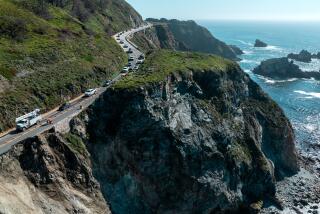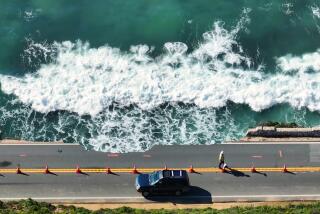Landslide: Mountain Loop Highway a wild ride out of Darrington

Mountain Loop Highway
DARRINGTON, Wash. — The landslide that killed at least 24 people near this mountain community also severed SR 530, the main highway out of town.
Before the March 22 catastrophe, it took about 30 minutes to drive west from Darrington to Arlington. Now, that route is blocked by debris up to 70 feet high, including mangled cars compacted to the size of small refrigerators, officials said Monday.
Residents can detour north, lengthening the drive to three hours and boosting their gas costs. Or they can take Mountain Loop Highway, which saves an hour but can take at least that much time off your life.
Fire crews and volunteers built a new road between the towns, which is for emergency traffic, such as ambulances, firetrucks and excavating equipment.
Steve Harris, who has been supervising rescue and recovery efforts on the Darrington side of the landslide, said Monday that as the weather has improved, workers have made progress, but the job is slow.
Dogs were still searching for bodies at sites marked with plywood signs or tree trunks spray-painted with a bright orange “PV” for “possible victim,” he said. It’s exhausting work.
The dogs, their handlers and others leave the scene coated in blue clay mud and must be decontaminated at special stations, Harris said. That’s also true of any personal effects recovered from the debris. After decontamination, the items are sorted and stored for return to survivors or relatives of the dead and the 30 still missing. Officials said it could take two to four weeks to return items to their owners.
“I can’t answer how long this is going to go on — there’s a lot of work to be done yet,” Harris said at a Monday briefing.
Officials offered Mountain Loop Highway as a temporary solution last week.
The southern detour is usually closed in winter because of flooding. It has also been closed for windstorms, sometimes for years.
Built on a wagon trail in 1936, the “highway” is strung together from forest roads, paved and unpaved, that dip and swirl through remote, unlit and uninhabited stretches of Mt. Baker-Snoqualmie National Forest. At the foot of the Cascade mountain range, the forest is home to one of the country’s largest winter gatherings of bald eagles, ice caves and more glaciers than any other national forest outside Alaska.
There’s still snow here in late March, piled several feet high along the road. Signs warn drivers to use all-wheel drive and be prepared for hazardous conditions.
Many drive it in small sedans, revving to make it through the mud.
The first nine miles out of Darrington are paved, but then the blacktop gives way to gravel and mud for 13 miles. After that, there are no streetlights or cellphone service and few spots to turn around. In some places, the two-lane road narrows to a single muddy lane with no shoulder. The speed limit is 25 mph, but there are few signs and even fewer people to enforce it.
Recent heavy rains have made the muddy passage even more slippery, a concern because the loop is mostly lined with massive, mossy fir trees, or drop-offs into deep wooded canyons, where the Sauk and Stillaguamish rivers roar.
Sometimes, it feels like a cross between Malibu Canyon and “The Hobbit.”
But unlike Malibu Canyon, there are no guardrails along many stretches of Mountain Loop.
Loggers in the area say the road doesn’t faze them. But even they hesitate to take it now.
Catharine and Larry Shaw of nearby Lake Stevens have ailing relatives in Darrington. They were so nervous about taking the Mountain Loop that they passed up a landslide victim fundraiser Sunday to take a test drive.
They drove their Nissan Armada, a formidable SUV, or, as Catharine Shaw likes to call it, “a beast.”
That didn’t help.
“We will be driving out on concrete,” said Shaw, 49, as they stopped at an espresso stand in Darrington before taking the long way home — coincidentally, through a town called Concrete.
Shaw has a nephew who lost two classmates in the landslide. Her niece in Darrington barely escaped, feeling the splash of wet debris. Now Shaw worries about the old logging town’s economy, which was struggling even before the landslide.
Storefronts sit empty, and some parking lots are too. The busiest spots seem to be the fire station and the IGA grocery store with its landslide map, emergency information and shrine in front.
“The town needs help getting in and out of here so they don’t lose the town,” she said, “How long is it going to take these people to recover emotionally, let alone financially?”
She said she hopes more people donate gas cards directly to Darrington residents to help them take the safer route.
Sean Frick also drove the loop from Lake Stevens on Sunday with his wife and two daughters, ages 8 and 10. As the family’s Isuzu SUV bumped over potholes the size of hubcaps, the girls complained.
“They were a little nervous,” he said.
They have a friend whose grandmother went missing in the landslide, and came to see the edge of the slide, stopping at the IGA shrine.
“Compared to some of the back roads, it’s not bad,” Frick said.
But sometimes the drivers are.
Kiara Frick was amazed to see a U-Haul van barreling toward them down a muddy slope. “That’s a little too fast for this road,” she said before the family piled back into their SUV, now coated in mud from the loop.
“I don’t trust it,” Marilee Goods, 61, said of the Mountain Loop.
Goods grew up in Darrington and returned this week after her brother-in-law was killed in the landslide.
She stopped for gas Sunday at the Mountain Loop Country Store before driving home to Post Falls, Idaho. She did not take the loop, and doesn’t plan to take it when she returns for the funeral next month. By then, she said, maybe things will have improved.
“So many people up here are out of work,” she said, “It’s going to take them a long time to get that road open. It’s going to be stressful for people.”
Two young Darrington women at the gas station said they have avoided Mountain Loop. But they are struggling to afford gas to drive the safer road.
Makala Johanson, 20, has to drive 100 miles to the Everett area, where she’s attending community college. During the last four days, she said, she has spent more than $150 on gas.
She worked at a local preschool, where she cared for some of the children who died in the landslide.
“I love this town. I grew up here. I won’t move,” said Johanson, wearing a neon green “Logger strong” T-shirt that serves as a fundraiser and a message of hope for slide survivors.
She doesn’t want to drive Mountain Loop, which she has only braved in summer and considers unsafe. She applied for gas vouchers but said she had trouble persuading officials that she needs them to drive to school.
Her friend Chrysta Coleman, 20, drives around for work each day as a caregiver for the elderly. She has to leave home at 4 a.m. to make the new drive.
“I have multiple clients, some who can’t walk, who count on me to be there to get their food and medications,” she said. “It’s difficult.”
The women bought $20 worth of gas, all they could afford. Then they said their goodbyes, shouting as they left, “Drive safe!”
More to Read
Start your day right
Sign up for Essential California for news, features and recommendations from the L.A. Times and beyond in your inbox six days a week.
You may occasionally receive promotional content from the Los Angeles Times.







